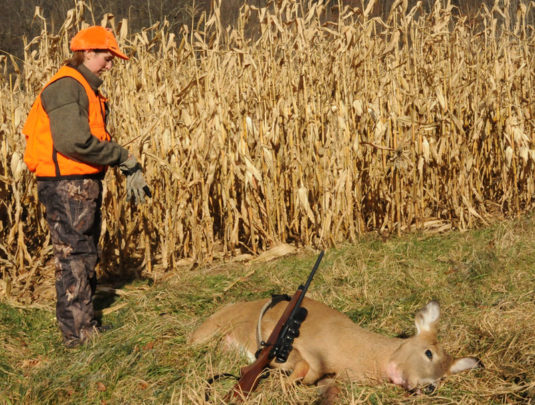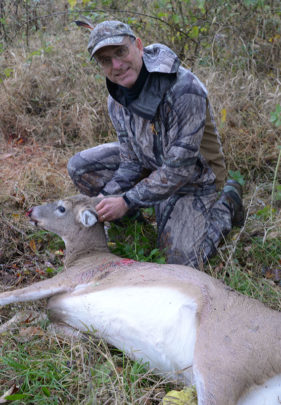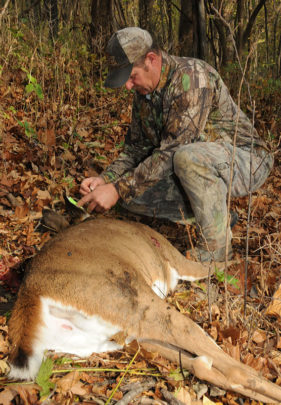As Wisconsin completes its 2015 deer hunting season this weekend, one wonders if we’ve swapped our state’s deer-management program for a simple deer-monitoring system.
That is, instead of managing the herd to keep it within the land and society’s carrying capacities, Wisconsin seems content to merely record the deer kill each fall. Meanwhile, we’ll just sit back and watch the herd grow, and shrug off its impact on crops, property, and forest and woodland habitats.

Wisconsin offers nearly four months of deer hunting, including bowhunting, crossbow hunting, youth gun-hunting, regular gun-hunting, and muzzleloading seasons.
All the data aren’t officially “final” for the nearly four-month deer hunt, which ended Jan. 3 for archery hunters, and included seasons for modern firearms and muzzleloading rifles. But in evaluating the data as of Feb. 7, it’s clear that deer herds in Wisconsin’s farm country – roughly two-thirds of the state – can’t be controlled with the current hunting regulations.
Consider: In May 2015, the state’s seven-citizen Natural Resources Board approved the Department of Natural Resources’ plan for hunters to shoot 224,735 antlerless deer (females and fawns) statewide. The DNR’s unofficial totals as of Feb. 7 show hunters registered 155,169 antlerless deer, or 69 percent of the goal.
The unofficial buck kill, meanwhile, was 151,446 as of Feb. 7, or 49.4 percent of the kill. But when you figure that roughly 24 percent of Wisconsin’s annual antlerless kill is buck fawns, you must subtract 37,240 of those antlerless deer and add them to the buck kill, which boosts it to 188,686 while reducing the doe kill to 117,929.
Final harvest totals: bucks, 61.5 percent; does 38.5 percent.

Wisconsin’s “new era” of deer management fell far short of statewide harvest goals for antlerless deer during 2015’s hunting seasons.
If the goal were to boost deer numbers statewide that would do it. But only one-third of Wisconsin – primarily its Northern and Central forests — called for increasing the herd. The rest (46 management units) had a citizen mandate to maintain (stabilize) or decrease deer numbers.
The combined antlerless quota for those 46 units was 190,450, but the actual harvest was roughly 133,000, or about 70 percent. Further, of those 46 units, only five – Barron, La Crosse, Marathon and Walworth counties, and the farmland half of Clark County – reached or exceeded their antlerless quotas.
Realize, too, that when DNR Secretary Cathy Stepp delivered her agency’s recommendations to the DNR Board in May 2015, she said the plan was “designed to manage deer toward population objectives established for each unit/county,” and that it represented “the next step in a new era of Wisconsin deer management.”
As Stepp noted, 2015 was the first year that Wisconsin’s “newly established County Deer Advisory Councils played a major role in establishing deer harvest quotas and permit-level recommendations for each management unit.” These councils are run by elected representatives of the Wisconsin Conservation Congress, citizen advisers to the DNR Board.
Unfortunately, citizens serving on these councils had only one option for controlling antlerless deer: Issue more antlerless tags. The Legislature – with Stepp’s capitulation and Gov. Walker’s signature – eliminated the earn-a-buck option in 2011.
And the fear many of those citizen councils expressed last winter proved true: The supply of antlerless tags would exceed hunters’ demand.
In addition to the free antlerless tag each hunter receives for farmland units, the DNR offered 143,825 bonus antlerless tags; $12 to residents, $20 to nonresidents, and $5 to 10- and 11-year-olds. As of season’s end, about 39,500 tags, 27.5 percent, remained unsold.
Further, of the 46 county-units trying to stabilize or reduce deer numbers, only four counties – Barron, La Crosse, Walworth and Clark’s farmland area – sold out their antlerless tags for private lands.
Which brings up another issue. In hopes of reducing hunting pressure on public lands and focusing it on private lands, the Wisconsin DNR now issues antlerless tags specific to public or private property in each county, and issues fewer for public lands. The result? Of the state’s 68 units selling private-land bonus antlerless tags, 44 units (65 percent) failed to sell their quota. Meanwhile, of the state’s 60 units selling public-land antlerless tags, only seven (12 percent) didn’t sell out.

Wisconsin hunters registered 155,169 antlerless deer during its 2015 seasons, or 69 percent of the goal set by its citizen advisory groups.
The shortcomings of the 2015 deer season were especially glaring in a deer-rich block of central Wisconsin that includes Marquette, Green Lake, Waushara, Portage, Waupaca, Shawano and Outagamie counties. Their combined antlerless harvest goal was 52,330, but hunters registered only about 25,500, 49 percent of it.
The results weren’t much better in the state’s core region for chronic wasting disease, which includes Dane, Sauk, Iowa, Rock and Walworth counties. The citizen advisory councils set a combined antlerless quota of 18,030 for those five counties, and hunters killed about 10,500, or 58 percent of the goal.
Meanwhile, the only deer-related number that’s stable or declining statewide is the hunting population, which is about 610,000, roughly 90,000 fewer than what Wisconsin had in the 1990s. Therefore, if this year’s deer seasons told us anything, it’s that no matter how large the farmland herd grows, hunters probably won’t kill many more antlerless deer than they did in 2015.

 By
By 



